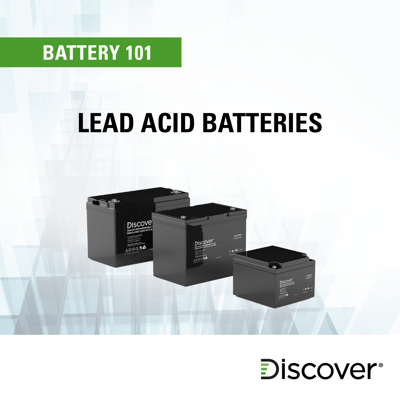As part of our Battery 101 series, we will explore all about lead-acid batteries.
General Lead Acid Battery Chemistry
A battery can be described by the Chemistry of the alloys used in the production of the battery's grids or plates.
- Calcium/Calcium alloys
- Calcium/Antimony hybrid alloys
- Antimony and High Antimony alloys
Amongst other things, the alloy (chemistry) used in the production of the battery will dictate how well the battery will cycle, how long it will live when properly maintained, how much it will gas when being discharged and recharged and how much water it will use as it works.
Typically, calcium/calcium alloys will use less water and will live better in heat. Batteries made with Traction Type calcium/calcium plates will have the added advantage of long life in Deep Cycle Traction applications as well as reduced or eliminated maintenance requirements.
Batteries made with higher Antimony alloys will generally deliver good cycle or run times and life in cyclic applications but will use more water in the process requiring rigorous maintenance schedules.
Calcium/Antimony hybrid alloys will perform somewhere in between.
Lead acid batteries are generally referred to as: Flooded, GEL, AGM, Traction Gel, and Dry Cell Traction batteries. Each of these lead acid batteries consist of a different construction composition, chemistry make up, and application use.
Construction (Type):
- Sealed Valve Regulated Starved Electrolyte
- Sealed Maintenance Free Flooded
- Accessible Maintenance Free Flooded
- Maintenance required Flooded such as industrial batteries or golf cart batteries
Chemistry:
- Calcium/Calcium alloys
- Calcium/Antimony hybrid alloys
- Antimony and High Antimony alloys
Application:
- Starting – for engine starting applications
- Float – for UPS/Telecom or standby applications
- Cyclic – for light duty loads in RV/Marine or recreational applications
- Deep Cycle – for medium duty loads in RV/Marine and Renewable applications
- Traction – for high rate deep cycling loads in industrial and commercial applications
General Lead Acid Battery Applications
Batteries can be referred to by the Application they were designed for.
These applications will range from pure starting to pure cycling or deep cycling and many applications have needs somewhere in between.
- Starting: for engine starting applications
- Float: for UPS/Telecom or standby applications
- Cyclic: for light duty loads in RV/Marine or recreational applications
- Deep Cycle: for medium duty loads in RV/Marine and Renewable applications
- Traction: for high rate deep cycling loads in industrial and commercial applications
General Lead Acid Battery Types
There are many different batteries currently in production today worldwide.
Lead Acid Batteries can generally be described first by Type or Construction:
- Sealed Valve Regulated Starved Electrolyte
- Sealed Maintenance Free Flooded and
- Accessible Maintenance Free Flooded
- Maintenance required Flooded such as industrial batteries or golf cart batteries
Sealed Valve regulated or Starved Electrolyte types use a solution of sulfuric acid and water suspended in a GEL or absorbed into a glass-mat (AGM). There is no excess electrolyte to leak out even if tipped or turned upside down. This sealed, non-spillable characteristic is a product of the construction and chemistry of the battery design.
Sealed Maintenance Free Flooded and Accessible Maintenance Free Flooded types use a solution of sulfuric acid and water that can spill out of the battery if it is tipped. Even though the Sealed Maintenance Free Flooded batteries are not accessible, electrolyte will eventually leak out through the vents if tipped.
General Lead Acid Battery Chemistry
A battery can be described by the Chemistry of the alloys used in the production of the battery's grids or plates.
- Calcium/Calcium alloys
- Calcium/Antimony hybrid alloys
- Antimony and High Antimony alloys
Amongst other things, the alloy (chemistry) used in the production of the battery will dictate how well the battery will cycle, how long it will live when properly maintained, how much it will gas when being discharged and recharged and how much water it will use as it works.
Typically, calcium/calcium alloys will use less water and will live better in heat. Batteries made with Traction Type calcium/calcium plates will have the added advantage of long life in Deep Cycle Traction applications as well as reduced or eliminated maintenance requirements.
Batteries made with higher Antimony alloys will generally deliver good cycle or run times and life in cyclic applications but will use more water in the process requiring rigorous maintenance schedules.
Calcium/Antimony hybrid alloys will perform somewhere in between.







